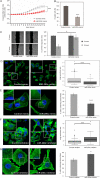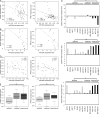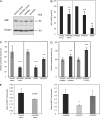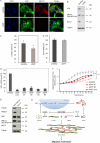MicroRNA-200c represses migration and invasion of breast cancer cells by targeting actin-regulatory proteins FHOD1 and PPM1F
- PMID: 22144583
- PMCID: PMC3266604
- DOI: 10.1128/MCB.06212-11
MicroRNA-200c represses migration and invasion of breast cancer cells by targeting actin-regulatory proteins FHOD1 and PPM1F
Abstract
MicroRNA-200c (miR-200c) has been shown to suppress epithelial-mesenchymal transition (EMT), which is attributed mainly to targeting of ZEB1/ZEB2, repressors of the cell-cell contact protein E-cadherin. Here we demonstrated that modulation of miR-200c in breast cancer cells regulates cell migration, cell elongation, and transforming growth factor β (TGF-β)-induced stress fiber formation by impacting the reorganization of cytoskeleton that is independent of the ZEB/E-cadherin axis. We identified FHOD1 and PPM1F, direct regulators of the actin cytoskeleton, as novel targets of miR-200c. Remarkably, expression levels of FHOD1 and PPM1F were inversely correlated with the level of miR-200c in breast cancer cell lines, breast cancer patient samples, and 58 cancer cell lines of various origins. Furthermore, individual knockdown/overexpression of these target genes phenocopied the effects of miR-200c overexpression/inhibition on cell elongation, stress fiber formation, migration, and invasion. Mechanistically, targeting of FHOD1 by miR-200c resulted in decreased expression and transcriptional activity of serum response factor (SRF), mediated by interference with the translocation of the SRF coactivator mycocardin-related transcription factor A (MRTF-A). This finally led to downregulation of the expression and phosphorylation of the SRF target myosin light chain 2 (MLC2) gene, required for stress fiber formation and contractility. Thus, miR-200c impacts on metastasis by regulating several EMT-related processes, including a novel mechanism involving the direct targeting of actin-regulatory proteins.
Figures













Similar articles
-
The effects of Micro-429 on inhibition of cervical cancer cells through targeting ZEB1 and CRKL.Biomed Pharmacother. 2016 May;80:311-321. doi: 10.1016/j.biopha.2016.03.035. Epub 2016 Apr 5. Biomed Pharmacother. 2016. PMID: 27133071
-
MiR-200c suppresses TGF-β signaling and counteracts trastuzumab resistance and metastasis by targeting ZNF217 and ZEB1 in breast cancer.Int J Cancer. 2014 Sep 15;135(6):1356-68. doi: 10.1002/ijc.28782. Epub 2014 Mar 3. Int J Cancer. 2014. PMID: 24615544
-
miR-200 promotes the mesenchymal to epithelial transition by suppressing multiple members of the Zeb2 and Snail1 transcriptional repressor complexes.Oncogene. 2016 Jan 14;35(2):158-72. doi: 10.1038/onc.2015.69. Epub 2015 Mar 23. Oncogene. 2016. PMID: 25798844
-
miR-200c: a versatile watchdog in cancer progression, EMT, and drug resistance.J Mol Med (Berl). 2016 Jun;94(6):629-44. doi: 10.1007/s00109-016-1420-5. Epub 2016 Apr 20. J Mol Med (Berl). 2016. PMID: 27094812 Review.
-
MicroRNAs Regulating Cytoskeleton Dynamics, Endocytosis, and Cell Motility-A Link Between Neurodegeneration and Cancer?Front Neurol. 2020 Nov 9;11:549006. doi: 10.3389/fneur.2020.549006. eCollection 2020. Front Neurol. 2020. PMID: 33240194 Free PMC article. Review.
Cited by
-
miR-200c dampens cancer cell migration via regulation of protein kinase A subunits.Oncotarget. 2015 Sep 15;6(27):23874-89. doi: 10.18632/oncotarget.4381. Oncotarget. 2015. PMID: 26203557 Free PMC article.
-
Ubiquilin Networking in Cancers.Cancers (Basel). 2020 Jun 15;12(6):1586. doi: 10.3390/cancers12061586. Cancers (Basel). 2020. PMID: 32549375 Free PMC article. Review.
-
miRNA signatures can predict acute liver failure in hepatitis E infected pregnant females.Heliyon. 2017 Apr 6;3(4):e00287. doi: 10.1016/j.heliyon.2017.e00287. eCollection 2017 Apr. Heliyon. 2017. PMID: 28413835 Free PMC article.
-
Impact of trifluoromethyl Ugi adducts as anticancer agents: EGFR inhibition, apoptosis induction and miRNA up-regulation.RSC Adv. 2025 Jun 10;15(24):19530-19545. doi: 10.1039/d5ra01428j. eCollection 2025 Jun 4. RSC Adv. 2025. PMID: 40496375 Free PMC article.
-
MicroRNA-200c regulates the sensitivity of chemotherapy of gastric cancer SGC7901/DDP cells by directly targeting RhoE.Pathol Oncol Res. 2014 Jan;20(1):93-8. doi: 10.1007/s12253-013-9664-7. Epub 2013 Jul 3. Pathol Oncol Res. 2014. PMID: 23821457
References
-
- Blick T, et al. 2008. Epithelial mesenchymal transition traits in human breast cancer cell lines. Clin. Exp. Metastasis 25:629–642 - PubMed
Publication types
MeSH terms
Substances
LinkOut - more resources
Full Text Sources
Other Literature Sources
Medical
Research Materials
Miscellaneous
